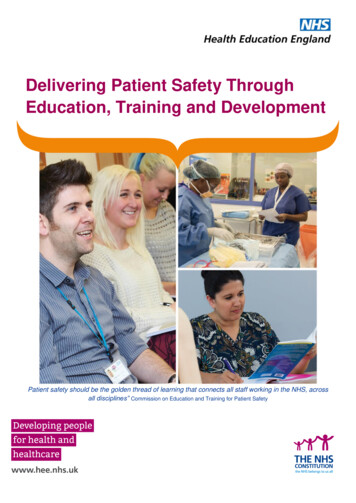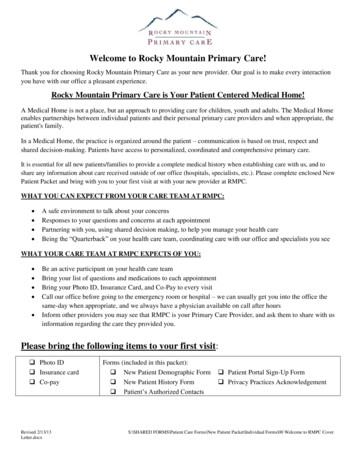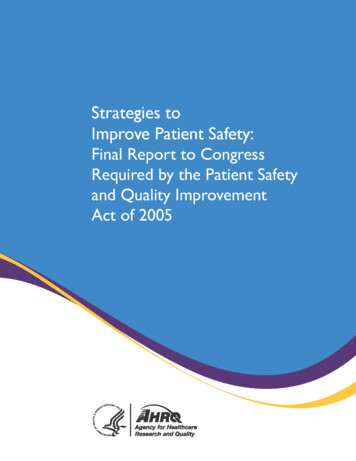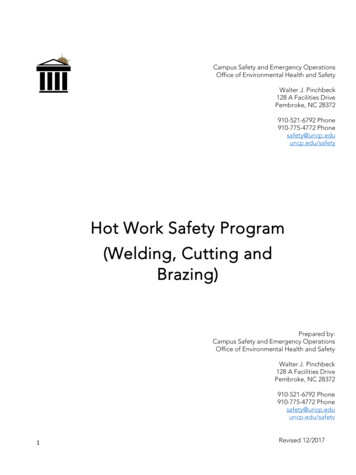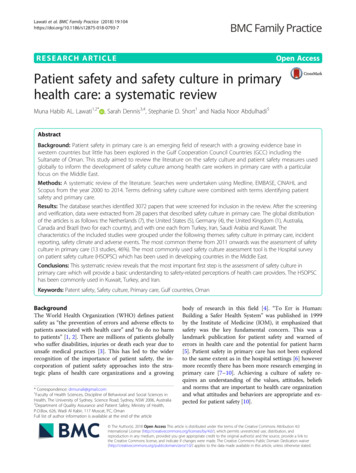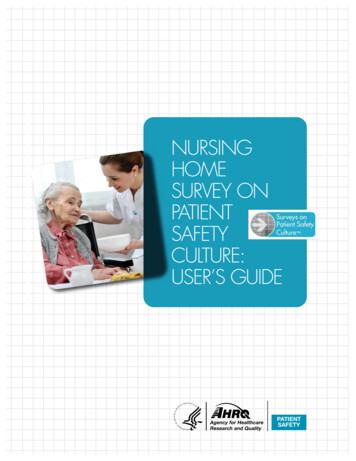
Transcription
Curr Treat Options Peds (2019) 5:131–144DOI 10.1007/s40746-019-00156-5Patient Safety (M Scanlon, Section Editor)Patient Safety: What IsWorking and Why?Thomas Bartman, MD, PhD1,2,*C. Briana Bertoni, MD, LSSBB, MBOE3Jenna Merandi, PharmD, MS, CPPS4Michael Brady, MD2,5Ryan S. Bode, MD2,6Address*,1Quality Improvement Services, Nationwide Children’s Hospital, 700 Children’sDrive, Columbus, OH, 43205, USAEmail: thomas.bartman@nationwidechildrens.org2Department of Pediatrics, The Ohio State University College of Medicine, 370 W9th Ave, Columbus, OH, 43210, USA3Clinical Fellowship in Quality and Safety Leadership, Nationwide Children’s Hospital, 700 Children’s Drive, Columbus, OH, 43205, USA4Nationwide Children’s Hospital, 700 Children’s Drive, Columbus, OH, 43205, USA5Patient Safety, Nationwide Children’s Hospital, 700 Children’s Drive, Columbus,OH, 43205, USA6Hospital Medicine, Nationwide Children’s Hospital, 700 Children’s Drive, Columbus, OH, 43205, USAPublished online: 11 April 2019* Springer Nature Switzerland AG 2019This article is part of the Topical Collection on Patient SafetyKeywords Patient safety I Culture I Event reporting I Electronic health record I Quality improvement I StandardizationAbbreviations IOM Institute of Medicine ADE Adverse drug event QI Quality improvement HAI Healthcareacquired infection CLABSI Central line-associated bloodstream infection SSI Surgical site infection CAUTICatheter-associated urinary tract infection VAP Ventilator-associated pneumonia CDC Centers for Disease ControlHIPAA Health Insurance Portability and Accountability Act CDS Clinical decision support ICU Intensive careunitISMP Institute for Safe Medication Practices WAD Work as done WAI Work as imaginedAbstractPurpose of review Our goal is to review a number of methodologies which have been used toimprove safety in healthcare since the release of the Institute of Medicine report in 1998which documented that error was a significant cause of mortality in the USA.Recent findings Multifaceted approaches have each led to reduction in error. Methods forerror reduction included in this review are BJust Culture, increased transparency andaccountability, error reporting and investigation, second-victim programs, training inquality and safety methods, standardization and bundles, electronic health records,computerized order entry, barcode scanning, clinical decision support, predictive
132Patient Safety (M Scanlon, Section Editor)analytics, and situational awareness. Newer fields with the potential to improve patientsafety include human factors engineering, indication-based prescribing, and Safety II.Summary While each intervention has led to incremental improvement, continued expansion of these programs is necessary to eliminate medical error.IntroductionAs health care continues growing in complexity daily,concerns regarding patient safety grow with it. Over twodecades ago the Institute of Medicine (IOM) reportedthat as many as 98,000 people die annually from preventable harm [1]. A more recent analysis (althoughcontroversial and using different methodology thanthe IOM) suggested that medical errors currently cause250,000 American deaths each year which would makeerror the third leading cause of death second to cancerand heart disease [2]. Regardless of the true incidence ofmedical error leading to harm, only one goal is clearlyacceptable to any individual patient or family—zeropreventable harm [3, 4]. We must achieve this in thecontext of patients living longer with multiple comorbidities and acute conditions and having higher expectations for quality of care. Increased awareness of ourdeficiencies in patient safety has led to numerous strategies for improving the quality and safety of care despitetrends towards increased disease severity. This reviewcovers many of these strategies; some are generalizablewhile others are more specific. Finally, we suggest a fewup-and-coming areas which will potentially drive safetyresults further.BJust culture Perhaps the most important element for improving patient safety is organizational culture. Hospitals with a BJust Culture share accountability in doing theright thing, both in leadership and the frontline staff. The BJust Culture focuseserror-prevention efforts on improving system design and behavioral choices [5].A BJust Culture recognizes that humans are destined to make mistakes [6], anddrift at times into at-risk behaviors, no matter how well hospitals design theirsystems. However, BJust Culture requires leaders and management to pursuefollow-up actions that correct errant behaviors irrespective of those involved orthe outcome of a particular error event. When management successfully differentiates between human error, at-risk behavior, and reckless behavior, appropriate actions are taken which may include consoling, coaching, or discipliningthe individual involved [7].Transparency/accountabilityOrganizations which desire to create a high-safety culture must emphasizetransparency—open disclosure of information regarding safety and safetyevents with patients, the public, and other healthcare providers [8]. Withouttransparency, healthcare providers have no opportunity to learn from eachother’s mistakes, which increases the odds of similar errors in the future [8].Some organizations have recognized the need for transparency and publish
Patient Safety: What Is Working and Why?Bartman et al.133their quality and safety results on the Internet, which may drive patient choiceand influence staff buy-in to improve safety outcomes [9]. Becoming a Bhighreliability organization (one that operates in a complex, highly-hazardousdomain for an extended period without failure) requires that hospitals dedicatethemselves to consistent safety accountability and effective patient-centered care[10].Event reporting and investigationFrontline employees must identify and report events so problematic issuescan be addressed [1]. As a hospital’s safety culture matures, an increase involuntary reporting may occur along with other ways of detecting adverseevents such as trigger tool analysis [11]. Increased event identificationthrough reporting and triggers, followed by robust analysis such as rootcause analysis identifies individual and system failures, and improves theability to understand not only the gaps in our systems, which led to anevent, but also to identify and rectify latent errors—errors in waiting [12].After a harmful event, methods such as the Bhuddle process encourage thegathering of interdisciplinary teams who examine what specifically happened and determine appropriate remedial actions to prevent reoccurrence[13]. Hospitals have been successful in utilizing the huddle to identifyinterventions at the individual, unit, or system level to reduce adverse drugevents (ADEs) [14, 15]. Event reporting and investigation is best applied asa multifaceted approach. One institution, which reduced harmful ADEs byapproximately 80%, suggested four critical factors for success—a robustinternal quality collaborative model, focus on medication managementfailure modes, ADE huddles, and increased event reporting in an evolvingsafety culture [16]. Institutions which hope to achieve higher levels ofvoluntary event reporting must recognize that the BJust Culture describedpreviously is critical to making employees feel safe to report instead ofcover-up problems.Second victim programsDespite efforts to reduce and eliminate preventable harm,errors—sometimes tragic—will still occur. Healthcare professionals areoften abandoned while dealing with the emotional impact following theseunfortunate incidents and can have trouble coping with their emotionsand reactions [17, 18]. Wu coined the term Bsecond victim, defined asBthose who suffer emotionally when the care they provide leads to patientharm [19]. Years later, the definition was expanded by Scott and colleagues to include those Bhealthcare providers involved in unanticipatedadverse patient events, medical error, and/or patient-related injury whobecome traumatized by the event [20]. BSecond victims go throughdistinct recovery stages following these events [21], and institutionallydesigned programs providing peer support can reduce emotional distressand improve professional quality-of-life [21, 22]. Second victims oftendesire support from a coworker, peer, or an individual who helps themlearn from their mistake and decreases the involved worker from feeling
134Patient Safety (M Scanlon, Section Editor)isolated [21, 23, 24]. Hospitals must find ways to rapidly respond togrieving healthcare providers and make accessible support mechanismsswiftly available [21, 25]. Healthcare providers often suffer in silence, andif we desire to continue improving patient safety, we must improve employee safety as well.Training in quality and safety methodsInstitutions can accelerate patient safety improvement efforts through motivated interdisciplinary teams, which include physicians, nurses, pharmacists,administrators, risk managers, and other individuals in place, to help organizations make improvements going forward [26]. Though many of these individuals might have the knowledge and skill to lead change [26], some believestandardized quality improvement (QI) training in areas such as change management and teamwork is necessary for institution-wide QI [27]. One studyevaluated four core areas: QI knowledge, testing and implementing changeusing teams, data management and analysis, and spreading and sustainingscience following a QI essentials course [28]. Teaching the Institute forHealthcare Improvement Model for Improvement [29], the authors found thathaving interdisciplinary teams participating in the course made drastic improvements in QI competency over time and increased QI productivity [28].Training hundreds of mid-level and senior leaders in a project-based course hascreated a Bcan do QI culture in the institution. Continued execution of QItraining programs will enable more individuals throughout health-systems topractice improvement methods towards increasing care quality and reducingpatient harm. The expected result is organizations will build a solid Bbottomup foundation for QI while supporting high-reliability at the system level [30].Standardization/bundlesCare standardization, often through bundled implementation, speaks to afundamental definition of quality as a reduction in variation [31]. Standardization has achieved reductions in a critical function that has harmed patientssince the origin of healthcare—Healthcare-Associated Infections (HAIs). Initially, HAIs resulted from poor hygiene and sanitation and failure to understandgerm theory. More recently, HAIs have been associated with surgical procedures,use of invasive devices, and therapies adversely affecting the immune system.When the device-related HAIs began to occur, physicians rationalized theseinfections as the cost of caring for critically ill patients. Central line-associatedbloodstream infections (CLABSI), surgical site infections (SSI), catheterassociated urinary tract infections (CAUTI), and ventilator-associated pneumonia (VAP) are the most common and most serious HAIs. Since not allpatients with invasive devices develop HAIs, specific patient characteristics anddevice care-related activities identified risk factors enhancing or reducing anindividual patient’s likelihood of acquiring an HAI. Understanding these riskfactors led to interventions that have significantly reduced HAIs.For each HAI, specific interventions were trialed, usually Bbundled together, reducing contamination of a previously sterile or clean site during surgery ordevice insertion and minimizing indwelling device manipulation to reduce
Patient Safety: What Is Working and Why?Bartman et al.135subsequent contamination. The resulting insertion and maintenance Bbundles for each device-associated HAI are evidence-based and standardized [32–37].Because the risk for a device-related HAI increases while any invasive deviceremains in a patient, all device maintenance bundles require a daily conversation to determine if the device is still essential. This practice ensures removal assoon as feasible when devices are no longer medically necessary.Insertion and maintenance bundles vary by device. For each device, the useof standardized bundles for insertion and maintenance requires high compliance levels for full effectiveness. The Centers for Disease Control and Prevention(CDC) through its National Healthcare Safety Network determined that intensive care units (ICUs) utilizing these standardized insertion and maintenancebundles reduce CLABSIs by at least 38% (see Table 1 for one bundle example).However, achieving this magnitude of CLABSI rate required compliance at 995% for all bundle elements [38].In 2009, the eight children’s hospitals in Ohio created Solutions for PatientSafety [39] as a network to improve patient safety by utilizing evidence-basedpractices, such as the HAI bundles, to reduce patient harm. The network hasgone national, and even international, with more than 130 children’s hospitalsparticipating. Since 2011, with standardized bundle use, the network hospitalshave reduced SSIs by 31.2%, CAUTIs by 58.8%, and CLABSIs by 12.1% [40 ].Evaluations of the impact of each specific device-related bundles wereconducted as multi-modal interventions and not an assessment of individualspecific bundle elements. Therefore, the benefit of each element is notestablished. Since the bundle elements add cost and provider time, identifyingwhich bundle elements provide benefit and which do not would be valuable.However, bundle success may preclude efforts to assess individual bundleelements due to concerns that eliminating any bundle element could result inpotential patient harm.Electronic health records (EHRs)In the past 19 years, health information technology (HIT) advances havesignificantly contributed to patient safety. Perhaps the most widely adaptedadvancements are the EHR and computerized physician order entry (CPOE).Though EHRs first appeared in the 1960s [41], widespread adoption tookTable 1. CLABSI prevention bundle elementsInsertionMaintenanceHand hygieneDaily discussion of line necessity and functionalityChlorhexidine scrubRegular assessment of dressing integrityNo iodine treatmentStandardized access procedurePrepackaged or filled cart, tray, boxStandardized dressing, cap and tubing change (procedures and timing)Insertion checklistDaily chlorhexidine bathingFull sterile barrier for providers and patientsInsertion training for providers
136Patient Safety (M Scanlon, Section Editor)significantly longer due to some concerns, mostly related to cost, feasibility, andsecurity. In 2009, 10 years after the BTo Err is Human publication by the IOM,the federal government passed the Health Information Technology for Economic and Clinical Health (HITECH) Act [42], which afforded incentives forHIT use, including EHR use. The HITECH Act also expanded the Health Insurance Portability and Accountability Act (HIPAA) to provide coverage forelectronic-protected health information. This act catalyzed EHR adoption,which doubled from 34.8% of hospitals in 2007 to more than 71% in 2012[43].With HIT development, concerns about design problems, workflow disruption, and general dissatisfaction are numerous [44]. Thus, the use of a humanfactors approach (see below) to the design and development of further technology encourages careful evaluation and risk mitigation before EHR implementation is necessary. Despite safety concerns arising from EHR implementation, its application has been linked to enhanced vaccination rates [45] andimproved health care maintenance [46] in pediatrics and decreased inpatientmortality with enhanced use of auto-populated notes and records [47].Computerized order entry (CPOE)CPOE development, an advancement of EHR technology, has increased efficiency and safety, particularly when coupled with clinical decision support(CDS) tools. With nearly five billion drug treatment orders written annually,CPOE provides a Bclear alternative to hand-written orders [48]. CPOE targetsmedication-prescribing errors, which are believed to be the most prevalentADEs in hospitals [48, 49]. Utilizing CPOE can detect medication errors moreefficiently and automatically by checking that the medication is prescribed atthe appropriate dose; further, electronic order delivery increases pharmacyefficiency.Likewise, adding CDS to CPOE improves adherence to the medicationformulary and reduces ADEs by checking prescribed medications against apatient’s listed allergies or adverse reactions as well as automatically checkingfor drug-drug interactions [48]. CDS may also use warnings or hard stops,which limit medication doses to an appropriate range based on a patient’s ageor size or may require high-risk medications (e.g., anticoagulants or insulin) beordered with appropriate monitoring.Lastly, in the outpatient setting, CPOE can increase medication pick-up,particularly when linked to an automatic notification to primary care providers regarding non-compliance [48]. CPOE employment has been associatedwith reduced hospital mortality for pediatric patients [50].Barcode scanningA further advancement, barcode scanning, has addressed medication administration errors, which were unchanged with CPOE [49]. Before medicationadministration, a nurse scans both the medication and patient identificationband barcodes, which link to an order in the EHR. The administrator is warnednot to proceed if the patient does not have an order for the specific medication,including dose and route, due at that time. Using barcode scanning has reduced
Patient Safety: What Is Working and Why?Bartman et al.137wrong medication, wrong patient, wrong time, wrong route, and wrong-doseerrors. Though the five rights of medication administration will never bereplaced, barcode scanning, when used appropriately, can act as a defensivewingman to those administering medications. While not all medication errorslead to patient harm, and to our knowledge, no study has shown reduction inhospital-wide preventable harm or serious safety events after introduction ofbarcode scanning, at least one unit has shown a reduction in preventableadverse drug events upon introduction of this technology [51].Advances in HIT are just beginning to address pump programming errors.While smart pumps using dosing error reduction software can decrease someprogramming errors, many medication-infusion administration errors are stillpossible, including wrong rate, wrong concentration, wrong medication, andwrong dose. Smart pump integration links smart pumps to the EHR, such thatmedication administration requires barcode scanning the patient’s wristband,the medication, and the pump channel. The pump is then automaticallyprogrammed using the available order from the linked EHR. Also, the pumpautomatically administers the medication volume documented in the EHR atthe appropriate time, allowing for improved documentation. While relativelynew, smart pumps have the opportunity to decrease ADEs by decreasing thekeystrokes by approximately 86% [52] and improving pharmacy workflow byautomatically notifying the pharmacy when a bag or syringe is at a pre-specifiedlevel and needs to be replaced. As of January 2018, approximately 99% ofhospitals reported using smart pumps for IV medication administration, yetonly 15% used the pump’s interoperability function [53]. We anticipate seeinggreater evidence of improvement in patient outcomes as smart pump programming links become increasingly adopted.Clinical decision support (CDS)/predictive analyticsThe most recent introduction to the HIT arena includes the development ofpredictive analytics. Enhanced EHR use coupled with other IT advances, including wearable devices, created massive amounts of healthcare data. Predictive analytics, a branch of healthcare analytics, uses empirical methods todevelop predictions [54]. Despite being in the infancy of its development inhealthcare, predictive analytics has been used to forecast cardiac arrest inpediatric intensive care unit (PICU) patients [55 ], nephrotoxic-associate acutekidney injury [56], and cardiovascular deterioration in children with hypoplastic left-heart and similar cardiac lesions [57]. CDS and predictive analyticshave improved the early detection of sepsis in the ED with an automatedsolution requiring no additional documentation, identifying patients 68 minearlier when compared to the previous paper process [58]. A predictive modelhas been developed to detect pediatric inpatient deterioration outside of theICU setting up to 24 h before the event occurs (event being code blue, emergentPICU transfer, or patient death) with 85% sensitivity and less than a 2% falsepositive rate (Hoffman, J. – personal communication). Overall, predictiveanalytics’ ability to act as the Bwingman for busy and distracted healthcareproviders may lead to transformational improvement in patient safety. Onearea which should receive continued exploration is how behavioraleconomics—the effects of psychological, cognitive, emotional, cultural, and
138Patient Safety (M Scanlon, Section Editor)social factors on the economic decisions of individuals and institutions and howthose decisions vary from those implied by classical theory—can be adapted tonon-economic decisions in healthcare and how these factors affect CDS [59].Situational awarenessHospitalized pediatric patients with unrecognized clinical deteriorationand failed care escalation resulting in a code blue outside the ICU have anassociated increase in mortality. Initial studies demonstrated a 40–67%mortality with a 1-year survival rate of 15% [60]. With more timely andeffective resuscitation via pediatric code teams, both event survival andsurvival to discharge have improved significantly without a correspondingincrease in long-term neurological deficits [61]. Rapid response team(RRT) development has effectively led to rescuing clinical deteriorationand resulted in decreased codes outside the ICU and overall hospitalmortality. Initially demonstrated in a single pediatric facility, RRTs resultedin decreased in codes outside the ICU by 72% and a decrease in hospitalmortality by 18% [62]; two systematic reviews have recently affirmed thesefindings [63, 64]. However, RRT interventions usually represent a delayedrecognition of ongoing patient deterioration and subsequent rescue. Hospital systems are challenged to effectively intervene sooner towards a moreproximal capture of patient deterioration. This requires altering the trajectory of the decompensating hospitalized pediatric patient with prediction, identification, mitigation, and escalation of at-risk patients.Recent improvement efforts have focused on increasing situationalawareness [65], a term borrowed from the military and aviation industry, and which can be defined and summarized with three questions: (1)What is going on (with the patient/family, the unit, and providers)? (2)What does it mean (data points, analysis, and interpretation)? and (3)What is the predicted outcome (and potential mitigation and escalationplans)?Code blue teams and RRTs are system solutions targeting increasingsituational awareness, albeit interventions at the end of the deteriorationspectrum. Awareness and prediction tools such as the pediatric earlywarning scores (PEWS) have been well studied including most recently androbustly in a large multicenter prospective randomized control study,which did not show that PEWS significantly affected hospital mortality[66]. However, PEWS initiation did result in a decrease in definedBsignificant clinical deterioration events, which represented a more proximal capture of decompensation on the floor. Similarly defined events, alsoreferred to as unsafe or emergency transfers, are eightfold more commonthan code blue events and associated with increased morbidity and mortality compared to other ICU transfer patients [67]. Recent research andtechnological innovations have focused on electronic health record predictive analytic tools with several models outperforming PEWS in recognizing clinical deterioration for hospitalized patients [68]. In conjunctionwith more accurate predictive capacity, innovative models emphasizingsituational awareness with earlier identification, mitigation, and escalationhave favorably impacted unrecognized clinical deterioration [69, 70].
Patient Safety: What Is Working and Why?Bartman et al.139Preventing delayed or unrecognized clinical deterioration is a complexproblem requiring complex solutions. A multifaceted approach includingorganizational, operational, cultural, technical, and human factor solutionsare necessary to realize and sustain improvement.Future directions—human factors engineering (HFE)HFE is the Bscientific discipline concerned with understanding interactions among humans and other elements of a system [71]. As such,HFE recognizes that the systems in which we work require complexinterplay between humans (care providers) and equipment, supplies,and physical spaces. Efforts to optimize the latter elements withoutconsidering the role of fallible humans will limit gains seen throughsafety improvement efforts. HFE can be divided into the fields of physical ergonomics (how humans move through their workspace), cognitiveergonomics (how human interaction with technology affects decisionmaking), and macro ergonomics (how culture and organizational factorsaffect human performance). Since 2005, the IOM has been calling forincreased HFE consideration to improve patient safety [72]. A popularmodel for approaching HFE work in healthcare is the Systems Engineering Initiative for Patient Safety (SEIPS) model [73] for which anupdate has recently been introduced [SEIPS 2.0, [74]]. In SEIPS 2.0, thehumans at the center of the work system include both providers andpatients/families, the tools/technology, tasks, internal and external environments with which they interact, and the wider organization. Themodel suggests that the configuration of the components creates specificinteractions for any particular process and that process performancedepends on the interactions more than individual components. OneHFE example is having each physical item required for each step of atask arrayed in sequence from left to right in an equipment tray, thusminimizing or preventing inadvertent skipping of a task. Another HFEexample is a Bforcing function which prevents performing one stepuntil a prerequisite step is completed; for example, the OR case starttime cannot be entered into the EHR until a box has been checkedindicating completion of a procedural time-out.Future directions—indication-based prescribingMost practitioners are already familiar with the B5 Rights of medicationsafety—right patient, drug, dose, time, and route. In the last few years, especiallywith the advent of CPOE, a sixth right has been proposed—the right indication[75]. While some initial studies indicated that including the indication for themedication in the electronic order is effective at reducing medical errors [76–78], widespread adoption of this technology is lagging. An editorial from theInstitute for Safe Medication Practices (ISMP) [79] suggests indication-basedprescribing can provide multiple benefits. These advantages include, but are notlimited to, preventing errors by narrowing medication choices, especially withlook-alike drug names; empowering patients by helping them understandwhich medication they are taking for which purpose; improving
140Patient Safety (M Scanlon, Section Editor)communication between providers and pharmacists by revealing the patient’sdiagnosis list; and learning about off-label use. For indication-based prescribingto be effective, some hurdles must be overcome including defining terminologyfor indications, allowing the use of medications when a definitive diagnosis isnot known, and managing drugs used for multiple indications. Finally, theinformatics resources needed to implement these strategies with thousands ofmedications will be significant.Future directions—Safety IIThe predominant method for improving safety in healthcare over the lastdecades has been learning from our mistakes and redesigning systems toprevent recurrence. In this model, called Safety I, learning opportunities, whichdrive improvement, become limited as adverse events decrease. Furthermore, asthe more common failure modes are eliminated, future events tend to beunrelated to past events and thus cannot be prevented due to past learning. Ifour goal is zero harm (perfect safety), a shift in our thinking must occur.Safety II focuses on learning from what goes right and allowing individualsand systems to become more resilient. Hollnagel, Wears, and Braithwaite(2015) in their seminal whitepaper called for a shift towards Safety II [80 ].One key concept from Safety II is understanding how the actual work on thefront-lines differs from what is imagined by those not on the front-lines [workas done (WAD) vs. work as imagined (WAI)] [81]. The reason for the differencescan be common and mundane—such as a nurse simply triaging and resequencing tasks to get through a busy shift [82], or responding to the introduction of new technology in her workflow [83]. Alternatively, differencesbetween WAD and WAI can be responses to major events where front-lineworkers recognize a need to change their practices to avoid error. In these cases,a resilient response likely involves a four-step process of monitoring a situation,anticipating impending problems, responding effectively, and learning fromsuccesses achieved [84]. While Safety II is still an emerging field, and no reportsof Safety II being created de novo in a healthcare setting are available, a recentpaper described how Safety II seems to occur in a high-functioning unit andmay lead towards strategies for expand
4Nationwide Children 's Hospital, 700 Childrens Drive, Columbus, OH, 43205, USA 5Patient Safety, Nationwide Children 's Hospital, 700 Childrens Drive, Columbus, OH, 43205, USA 6Hospital Medicine, Nationwide Children 's Hospital, 700 Childrens Drive, Colum-bus, OH, 43205, USA Published online: 11 April 2019 * Springer Nature Switzerland AG .

